Directions for use
One of the main elements for this consistency is thorough mixing of the components. It must be applied within 5 minutes after mixing. If this is not done, complete hardening occurs. At a temperature of about 20 degrees, complete hardening occurs in 20 minutes, maximum 30 minutes.
The lower the temperature, the longer the hardening takes place, this must also be taken into account when performing finishes. If the expiration date has passed and the products have not been bought for a long time, the putty in the package cures.
The consistency dries quickly at a temperature of 40 degrees. In this case, in 12-15 minutes you will achieve a positive result.
When buying a hardener, you must pay special attention to the conditions of storage and transportation. The transport of the substance must be carried out at a temperature lower than 25 degrees Celsius
In this case, the possibility of freezing the consistency in special refrigerators is allowed. It is noteworthy that when thawed, the product does not have any deviations and retains the functions for which it was intended.
Home storage should follow a similar pattern. Storage temperature - from 0 to 25 degrees Celsius. Store only in packaging. Protect from sunlight, water, etc.
Mixing ratio
The time it takes for the solution to dry also depends to some extent on the hardener. Fast drying is achieved by even distribution and correct dosage of the substance. It is not necessary to add a large amount of hardener.
It is noteworthy that for 100 parts by weight it is necessary to add only 1-3 parts by weight of hardener. This will be enough for the entire consistency to dry. The number of parts by weight depends on the manufacturer. The package should indicate the amount to be mixed with the putty.
Important. In order for the consistency to be homogeneous, you need to do thorough and strong mixing of the mass, for several minutes and correctly dose
Tips and tricks for use
Firstly, each product has its own instructions, which are written on the package. Based on this source, you can independently apply the hardener at home.
The main rule before use is the addition of the substance, before the application itself. That is, in order to get the maximum effect from the putty, you need to prepare in advance all the tools for application, containers, for mixing, and then just mix. Another feature in the application is thorough stirring. If you notice that there is no significant change when mixing, then the possible reason is the expiration of the warranty period.
You should not take a long time to mix the consistency, as it can simply cool and harden. You need to mix for several minutes, but you need to do this intensively and thoroughly.
There is a lot of competition in the market for these products, since the sale of these materials is very profitable.
Popular manufacturers:
- Kaskol Kaskorit 2545;
- Reflex 50;
- Kestopur 200 \ S.
The first manufacturer is known all over the world. The British company provides high quality. The best option for application is putty on cars and other surfaces.
The second manufacturer does not use any solvents in its composition. Only those components are used that are necessary for the bonding. This saves putty and materials. On the basis of this tool, the seams become strong, but at the same time elastic.When adding material, the putty performs its functions much more efficiently.
The third manufacturer is focusing on the strengthening of joints in swimming pools and bathtubs. The best qualities of the product are the fight against moisture and water permeability, which is why it has such a scope. This product is white.
The hardener for putty is one of the most important elements for bonding materials, which has many useful functions. The use of the product is not limited to construction work. The popularity of hardener for car putty, decorative design is all target audience. In order not to miscalculate with the choice of a quality product, you need to use popular manufacturers. The better the firm, the more pure chemical elements will be present in the composition, contributing to the strengthening of materials, without the addition of solvents.
Peculiarities
Such products have a two-component base, which includes a resin with hardeners and fillers. The latter increase the strength characteristics that are so necessary for heavy mortars used in the elimination of defects and significant damage on wall structures. The most common fillers are fiberglass and metal shavings. Finishes that are thinly spread have the lowest levels of such additives.
Automotive epoxy putty is also used when painting metal surfaces or steel elements, while careful preparation of the planes is required to obtain the desired result.
Among the features of the putty, it is worth noting the average speed of hardening, which allows you to take your time after mixing it. The polymerization process begins after a certain time after spreading over the surface. Complete hardening occurs after 6-8 hours, after which finishing work can be carried out, including painting and grinding. Epoxy putty, the price of which is 264 rubles / kg, allows you to paint the walls without forming an insulating layer.
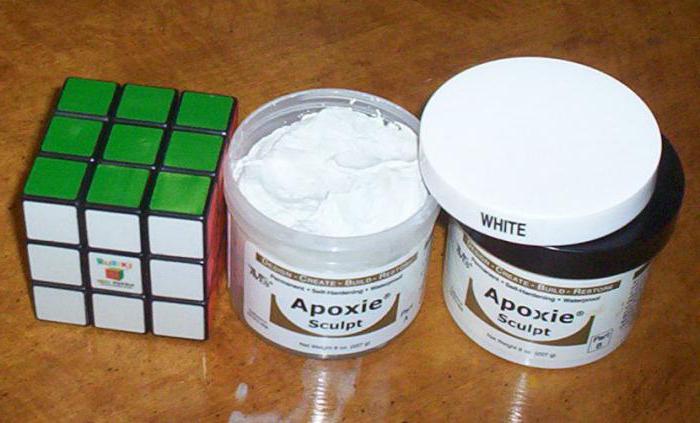
Material features
This type of repair mortar is characterized by slow hardening. Therefore, you should not rush while mixing the components until smooth.
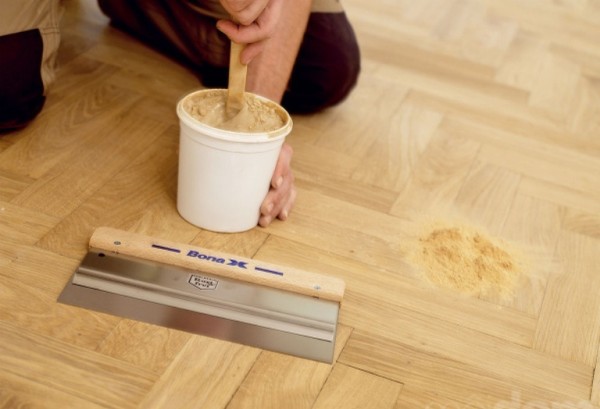 Wood putty
Wood putty
Fully epoxy putty cures after 6 hours. For EP-0010, the solidification time is 4-24 hours. You can start working with an area covered with such a composition after about 8 hours. It is usually sanded with sandpaper and painted. The advantage of the material is also that it is not necessary to create an insulating layer and primer. The surface will be completely ready for further work without it.
Consumption of EP-0010 and other brands depends mainly on the conditions of application and the method chosen for this.
If the process of hardening of the mixture has begun, which has not yet been used, it cannot be diluted with a solvent. In this case, the composition quickly loses its working properties. It is better to warm up the EP-0010 to a temperature of 80 degrees.
Features of epoxy mortars for different materials
In construction and in the process of finishing work, it will not be possible to do without a special finishing material, the types of which are many, however, not everyone is suitable for different occasions. Certain types of work require particularly high-quality mixtures that can provide excellent adhesion and easy handling in the future. Epoxy putty is the highest quality mortar that can be used on various surfaces. She can perfectly repair small cracks, scratches or chips. Depending on its composition, it can be waterproof, chemically resistant, without shrinkage during drying and not lose its qualities and properties for a long time.
 This mixture is perfect for sealing cracks and other irregularities.
This mixture is perfect for sealing cracks and other irregularities.
For leveling and processing metal elements, epoxy putties, which have excellent adhesion, are considered the best option. In addition, after drying, this composition is beautifully colored.
For metal, a mixture is used, where small metal filings act as a filler. Today in stores there is more often putty with aluminum powder.
 Small metal shards are used in the putty for metal
Small metal shards are used in the putty for metal
Professional craftsmen with such compounds perfectly smooth out damage on the car body. It is ideal to use this composition when there is a need to preserve the car for a long time, this prevents the appearance of corrosion.
Specially developed grades of epoxy putty with special properties can be used in shipbuilding.
Epoxy has also been used successfully on plastics due to its excellent elasticity and adhesion. Due to the presence of these qualities, it finds application in the repair of individual parts of cars, in the restoration of damaged PVC pipelines.
 The putty is perfect for finishing the car interior
The putty is perfect for finishing the car interior
This mixture is successfully used when restoring a used car, it fills all damage and cracks on the body. The disadvantage of the material is its toxicity, therefore, when applying, you should use masks for protection.
 Putty is often used to restore cars.
Putty is often used to restore cars.
Epoxy putty is ideal for processing concrete and aerated concrete, stone, brick, metal elements, glass and plexiglass, plastics and ceramics.
Application in the application of epoxy putty with fiberglass to various surfaces
The epoxy filler with fiberglass used for coating and leveling should be mixed in a certain proportion, taking into account that the weight of hardener must be taken 50 (g) for every 100 (g) of filler.
It is recommended to use this type of putty for repairing and removing damaged spots on boats in the area (above / below) the waterline. This type of epoxy putty is characterized by a fairly high degree of adhesion to any of the surfaces covered with this solution, among which it is worth highlighting:
- polyester fiberglass;
- epoxy fiberglass;
- wood;
- steel;
- various synthetic fibers;
- plastic.
This type of putty has found wide application and is used, as a rule, to eliminate defects that have arisen on the surface of polyester laminates, the surface area of which needs additional reinforcement.
Created in order to paint, level both metal and non-metal surfaces that work in harsh conditions, when immersed in fresh or salt sea water, various alkalis, as well as petroleum products ... Very often, in the process of using various products, various scratches, voids and potholes. To eliminate such defects, putties are currently used ... Currently, the building materials market is saturated with a large number of putties, differing in their properties. A significant place among them is given to epoxy putties ...> Epoxy putty: 4 main varieties Savig 5511 0 4
Variety No. 1: for wood
Wood is a very capricious material that often changes its volume depending on environmental conditions. For example, in the cold it shrinks, from an excess of moisture it expands. The considered type of epoxy putty mixture easily copes with such whims due to a number of features:
Specific traits
- No shrinkage during solidification;
- High elasticity;
- Ease of processing with your own hands;
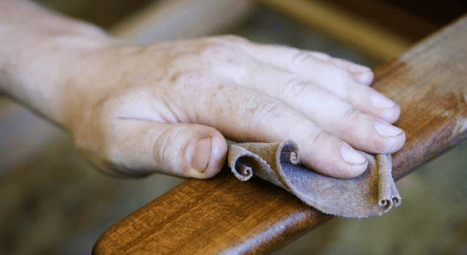
After sanding, places that have been patched with epoxy putty on wood will be difficult to distinguish from an untouched surface.
Possibility of painting in any shade.
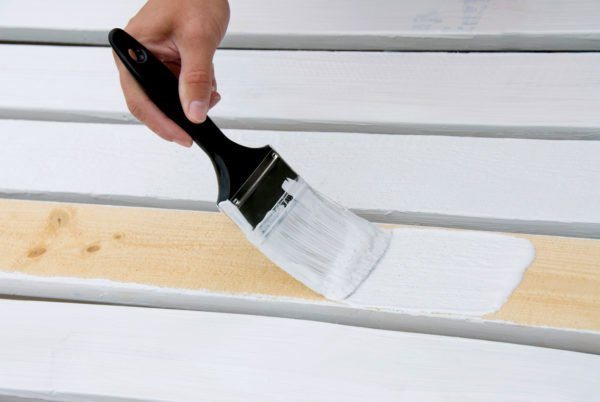
The filled areas can be painted even in pure white.
If in your plans to treat the wood after puttingtying with a stain, as is often done, for example, with floors, then I do not recommend using an epoxy compound, since it is not compatible with the specified finishing material.
Areas of use
- Sealing chips, cracks, scratches in wooden structures;
- Covering gaps and eliminating irregularities in the restoration of floors;
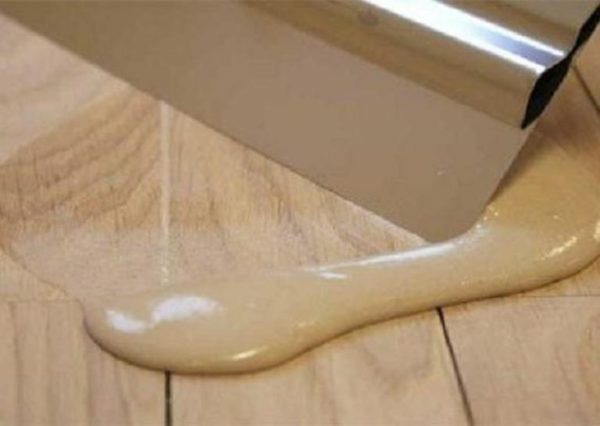
Epoxy wood filler helps seal joints between floorboards
Processing of doors and windows.
Recipe
You can make an epoxy putty for wood with your own hands:
| Photo | Description |
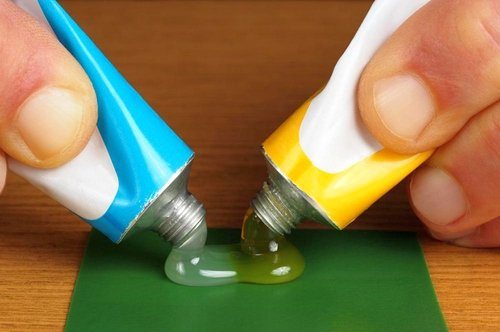 |
We combine epoxy resin with a hardener. |
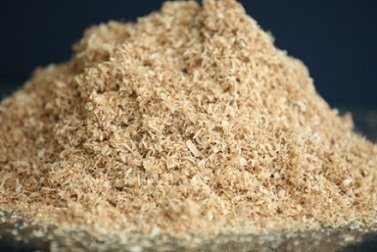 |
We add fine sawdust, gypsum and chalk to the mixture. |
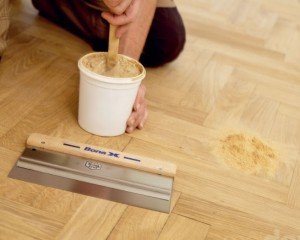 |
Mix thoroughly, after which the putty is ready for use. |
Using aluminum powder, crushed fiberglass or cement instead of sawdust as a filler, you can get an epoxy putty for metal, plastic and concrete, respectively.
Varieties
Epoxy putties are divided into several types according to the nature of the filler. They can work on wood, metal, plastic or concrete. Such compositions are also in demand among motorists for self-repair.
The use of epoxy putty partially restores and strengthens the structure of the base.
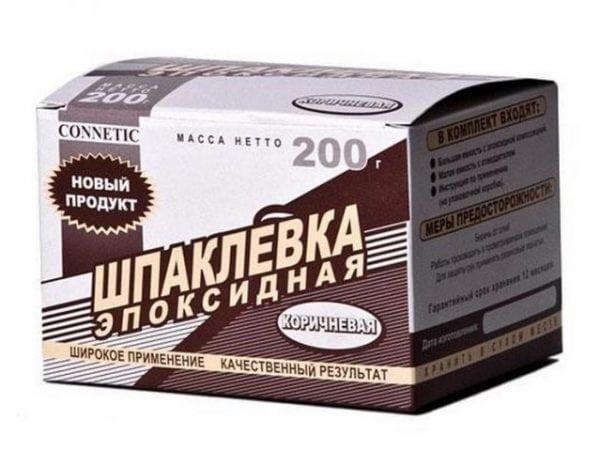
By wood
Wood is a moody material. When the temperature drops, it shrinks significantly, when it rises, it expands, the same thing happens in the drying / wetting cycle. Epoxy putty for wood can cope with such mobility of the material. It differs from other compositions in the absence of shrinkage after drying.
At the same time, it retains a certain elasticity, which is important when working with wood. In addition, it is perfectly processed and polished, it can be painted in any color you like.
There is, perhaps, one single drawback - such a putty cannot be stained. So, if it is planned to impregnate a wooden floor with a similar composition, it is better to refuse to putty with epoxy.
Epoxy wood putties are used:
- for sealing cracks, potholes, scratches;
- for repairing wooden floors when covering cracks, joints and even irregularities;
- with skillful work, doors, wooden windows, and other pieces of wooden furniture can be processed.
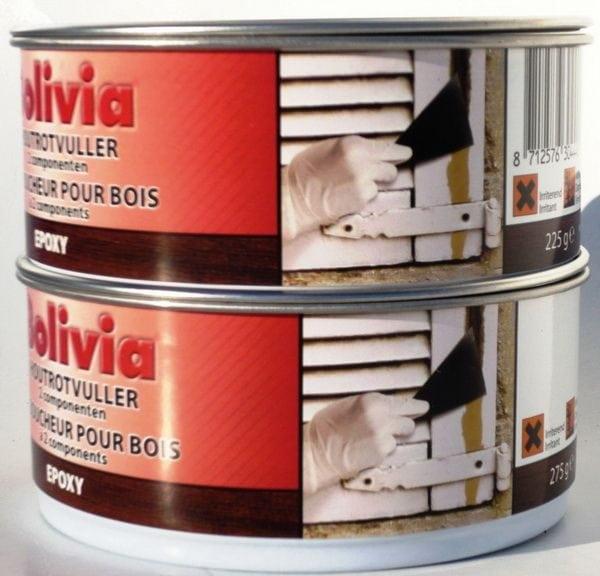
For metal
For leveling metal surfaces, epoxy putties are the best option. They have excellent adhesion
In addition, they lend themselves well to finishing sanding, which is important before final finishing (painting)
In order to perfectly align a metal sheet or any other metal object, formulations are used with filler in the form of the smallest sawdust from the same material from which the putty surface is made. Most often, compositions with aluminum powder can be found on sale.
Skillful motorists successfully process car body with such putties in places of damage. An epoxy composition is especially beneficial for long-term preservation of a car - it completely protects the metal from corrosion and rust.
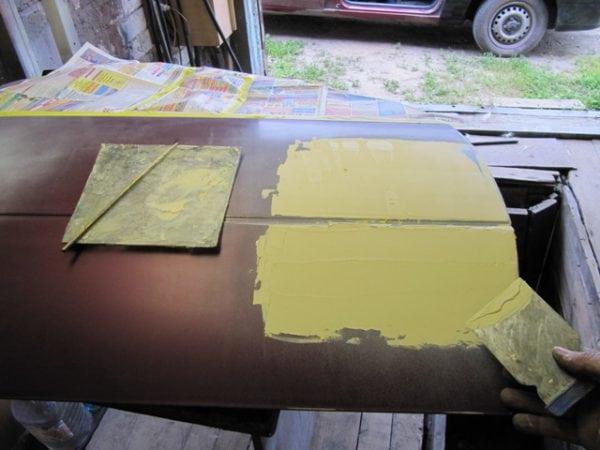
Special grades of epoxy putties for metal are used in ship repair shops, where special properties of the applied mixture are required.
On plastic
The use of epoxy on plastic surfaces is possible due to its excellent adhesion and elasticity. Thanks to such qualities, this repair material has found the most active use not only in the restoration of PVC pipes, but also in the repair of automotive equipment.
So, for example, epoxy restoring compounds for plastics are used with great success to bring used cars into a presentable form. The resin is able to fill all the bumps, dents and potholes on the car body. The only not very pleasant moment is the high toxicity of the used repair material.Therefore, to protect the lungs during work, it is necessary to use respirators and protective masks.
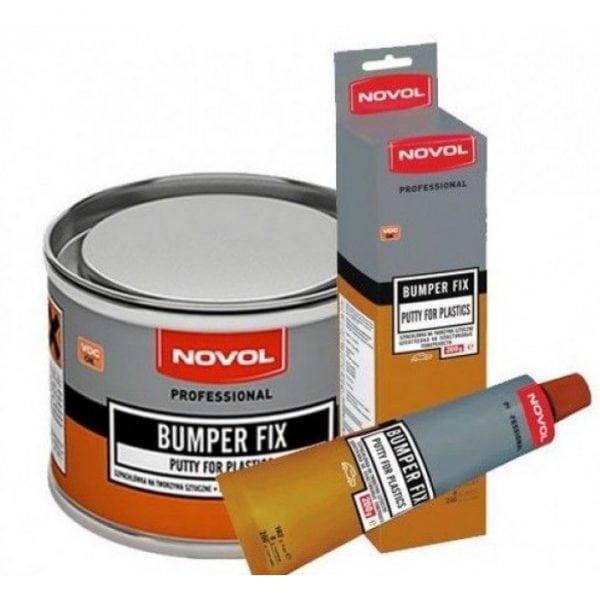
The technology of using epoxy putties is practically no different from the usual mixtures used. Before direct application, a small visual analysis of the damage to the surface (eg bumper) should be carried out. Then work according to the well-known scheme:
- clean plastic surfaces from dirt;
- clean the plastic parts with sandpaper;
- degrease surfaces with a special solvent;
- apply the putty to the damaged surface with a rubber spatula;
- Sand the restored part first with coarse-grained sandpaper, then with fine-grained sandpaper.
After these simple operations, the resulting part is ready for finishing painting.
On concrete
When working with such surfaces, epoxy impregnations for concrete are most often used. Usually, in addition to cement, coarse sand is also added to such compositions - to increase the adhesion of the base to the subsequent finish. After such impregnation, the concrete surface becomes rough and quite ready for plastering.
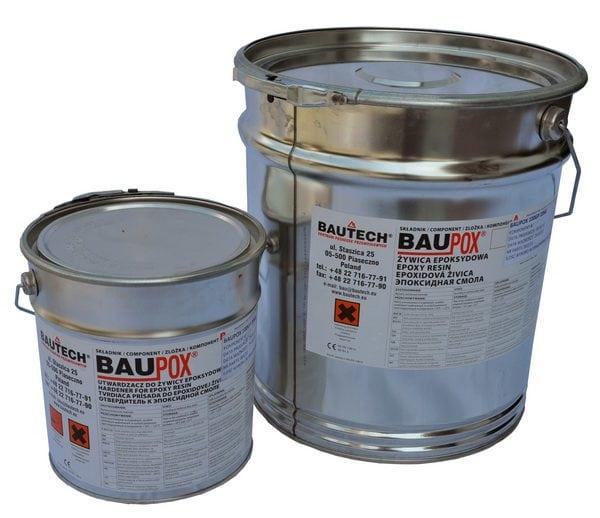
A regular epoxy adhesive (epoxy + hardener) is suitable for sealing cracks in concrete. It is prepared strictly according to the instructions, then the crack is filled and the surface is leveled. After complete polymerization, sandpaper.
When restoring large potholes, to reduce the cost of the mixture, a filler is added to the epoxy glue - cement or fine sand.
Manufacturers
The variety of epoxy putties on the construction market becomes a certain difficulty in choosing the right brand. And this is taking into account the fact that, as it turns out, it is quite possible to use inexpensive epoxy glue for work.
However, almost all well-known manufacturers of building and finishing materials produce epoxy putties for various types of surfaces. Among them are:
- Gypsum polymer;
- Kreps;
- VOLMA;
- Ceresit;
- Bergauf;
- Brozex;
- Knauf;
- Litokol;
- Pro;
- Unis;
- Weber Gifas, etc.
This is interesting: Do-it-yourself rafter system for a gable roof - consider in detail
Fast curing epoxy putty 250g. (5 hours) White. (Russia)
- Description
- Specifications
- Information about the company
- Article: F250
- Updated: 2019.11.
- Pickup
- Courier delivery
- Brand nameEAF
- The foundationepoxy
- Place of applicationfor interior work; for outdoor work;
- Application methodmanual
- Surface typefor concrete; for wood; for stone; for ceramics; for bricks; for metal;
- Applicationsfor paving stones; for tiles; for basements; for window sills; for the floor; for tanks; for walls; for facades;
- The weight0.25 kg
- Packagepack
- lack of smell;
- moisture resistance;
- coating strength;
- minimum shrinkage rates;
- resistance to the influence of aggressive liquids;
- ease of grinding;
- durability of use.
- EP-0020;
- EP-0010.
- For leveling the surface of floors, walls, ceilings. Moreover, it can be used for both concrete and stone or even wooden surfaces.
- For waterproofing.
- For bonding materials together. It can be used in particular for plastic, glass, wood, metal, ceramics, etc.
- For repairing minor damage, sealing joints and other repairs.
- As mentioned above, there are two separate sachets in the package, which contain the hardener and the putty mixture. Before use, separate the required amount of the substance from one sachet and the proportional amount of the hardener from the other sachet.
- Then both substances must be gently mixed until smooth.
- After the mixture has been prepared, it can be applied to the prepared surface, which does not have to be primed or even cleaned of paint if painted. The main thing is to simply degrease, after which you can apply the composition with your finger, spatula, brush or spray. The application method depends on the type of filler and its thickness.
- Then you need to wait 6-8 hours until it hardens completely. After that, the surface can be processed at your discretion, for example, sanding and painting. If a rough finish compound was used, then a finishing putty must be applied on top of it.
- Manufacturer's name;
- Quality passport;
- The technical name of the putty;
- Color after drying;
- Appearance after drying;
- Drying time at the specified temperature;
- Grinding degree;
- The ability of the putty to drain off a vertical surface;
- The share of volatile substances, in percent;
- Flexural elasticity;
- Impact strength;
- Ability to grind;
- Weight.
All characteristics
Description
The putty is supplied in a set: putty paste (based on epoxy modified resins, plasticizers and pigments) in a polyethylene can and a hardener in a polyethylene bottle, which are in one consumer package.
Application: The putty should be prepared immediately before the putty, by thoroughly mixing the putty paste and the hardener. Insufficient mixing can lead to uneven curing of the putty. To reduce the viscosity, it is allowed to dilute the solvent GOST 646. After the putty is prepared, it must be applied to the surface with a spatula. If it is necessary to close up a deep cavity, then this should be done in several layers, the layer thickness is not more than 8 mm. It is recommended to use fiberglass as a reinforcing material. To do this, it is necessary to apply a putty to the surface of the product, then apply fiberglass to it and then apply a layer of putty over the fiberglass. To remove the mold from the product ... Show more
The putty is supplied in a set: putty paste (based on epoxy modified resins, plasticizers and pigments) in a polyethylene can and a hardener in a polyethylene bottle, which are in one consumer package.
Application: The putty should be prepared immediately before the putty, by thoroughly mixing the putty paste and the hardener. Insufficient mixing can lead to uneven curing of the putty. To reduce the viscosity, it is allowed to dilute the solvent GOST 646. After the putty is prepared, it must be applied to the surface with a spatula. If it is necessary to close up a deep cavity, then this should be done in several layers, the layer thickness is not more than 8 mm. It is recommended to use fiberglass as a reinforcing material. To do this, it is necessary to apply a putty to the surface of the product, then apply fiberglass to it and then apply a layer of putty over the fiberglass. To remove the mold from the product, it is necessary to apply a separating layer on its surface (for example, based on wax), then apply glass cloth, on top of which, apply a layer of putty. After the putty has dried, remove the solidified mass from the product.
The time during which the putty is usable is about 30 minutes, depending on the ambient temperature, this time may vary. The curing time of the putty at a temperature of 20˚C is no more than 5 hours, a lower temperature increases the curing time. The hardened filler can be mechanically processed with sandpaper, file, etc. To obtain anticorrosive, waterproofing and chemically resistant coatings with subsequent use and operation of products in high humidity conditions.
Storage: epoxy putty is stored in covered, dry, ventilated warehouses, protected from moisture and direct sunlight.
Packing: 250 gr.
Expiration date: 12 months from the date of manufacture. TU 2312-029-75678843-2013
Specifications
Epoxy putty has gained recognition and widespread use in modern construction due to the following series of inherent positive properties:
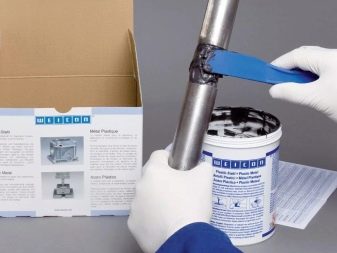

Due to the not particularly rapid hardening of the solution, it is possible to thoroughly stir its components until a uniform consistency is obtained. Also, one of the advantages of epoxy putty is the quality of application, which allows you to proceed with further surface finishing without additional priming. To preserve the basic properties of the mixture, solvents must not be used.
Epoxy putty is known not only for its high level of resistance to mechanical stress and the destructive effect of chemical compounds, but also for its ability to resist the appearance of mold and mildew. The listed properties explain the popularity of using the composition in question for carrying out not only internal, but also external construction work.
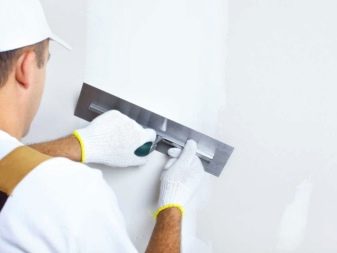

When choosing an epoxy putty, you should pay attention to its marking, which determines the main properties of the composition. The most popular are the following materials:
Each of the listed compositions, due to its special characteristics, is used to solve certain problems and has its own recommendations regarding the rules of use.
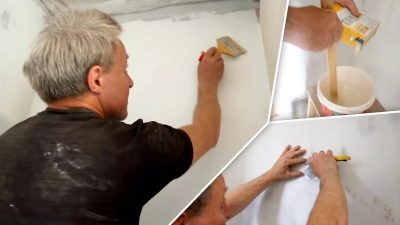
EP-0010
Epoxy putty of this marking is used mainly for the purpose of leveling the surface of products made of various materials. On sale, it can usually be found in the form of a thick pasty composition, which is brought to a liquid state by mixing with hardener No. 1 or diethylenetriamine.
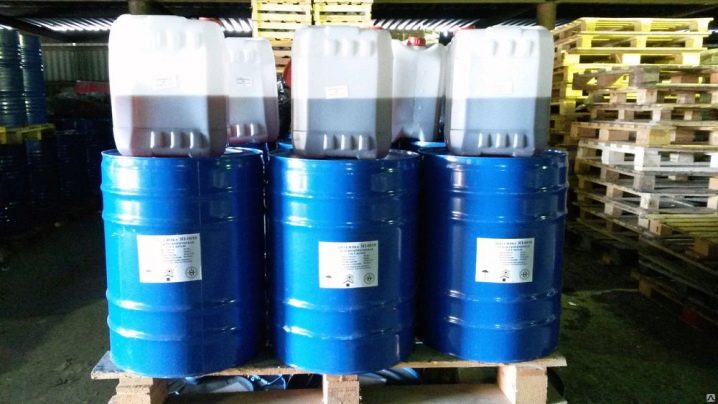
The main characteristics of the putty mixture allow it to be used both indoors and outdoors. The composition is applied both to the primed surface of the product, and without its preliminary priming. The average period of complete polymerization of the primer at an ambient temperature of 18-22 ° C is about a day, and when the temperature rises to 60-70 ° C - 7 hours.
The material in question can be applied to almost any surface. It should be noted that the EP-0010 epoxy primer has a fairly high elasticity, but when completely dried it forms a durable, smooth layer of red-brown color.
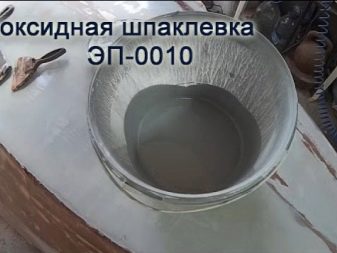
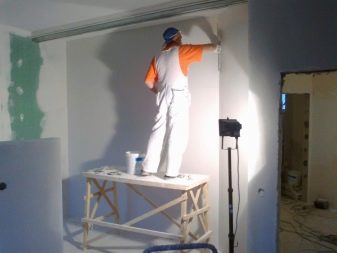
EP-0020
Epoxy putty with EP-0020 marking has a finely dispersed filler structure, which ensures an economical consumption of the composition for processing products of a certain area.
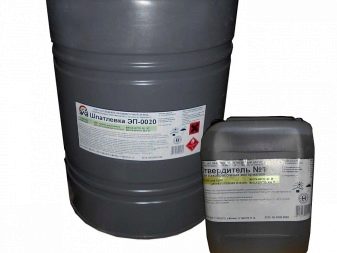

Using epoxy putty
Applications
This composition, like any other putty mixture, is used for various repairs and construction work:
Application of the composition
Before buying a product, you need to be familiar with the scope of its application and methods of use, which is usually indicated on the packaging. The point is that different formulations can be designed for different purposes.
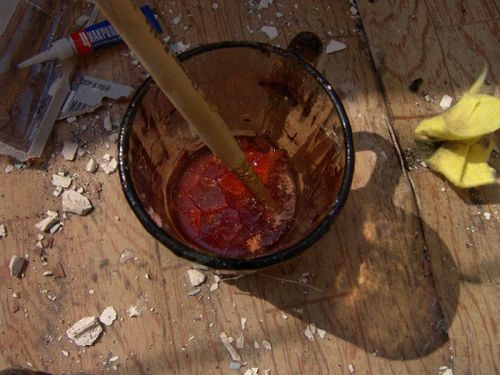
In the photo - a stirred putty
So, the instructions for using the putty are as follows:
I must say that you can buy such a putty in any hardware store, not necessarily intended for professionals, since the composition can be used in DIY home repairs.
Epoxy putty: quality certificate required
All material (including epoxy putty) must have a quality certificate. Products must comply with the established European standards, as well as the standards of the country of sale.
In addition to the quality certificate, there must be sanitary and epidemiological conclusions!
The certificates must be presented to the consumer upon request!
The quality certificate is the only reliable confirmation of the conformity of the goods to all the requirements of the standard
What is stated in the certificate:
This is followed by the conclusion of the laboratory of the technical control department and the signature of the head of the laboratory.
Before you buy a putty, you need to carefully study the instructions, make sure that this is the mixture you need. Only after finally making sure that it is she who is suitable for the purpose you need, you should purchase it.
Cooking yourself
It is not difficult to mix the epoxy putty yourself. This requires epoxy resin and a hardener. In addition, fillers can be useful, they are chosen taking into account the surface on which the ready-made mixture is planned to be applied.
When drawing up a solution for application to a tree, small sawdust should be prepared, you can mix them with gypsum or use chalk.
 Sawdust and chalk are often added to the wood solution.
Sawdust and chalk are often added to the wood solution.
Putty for metal involves the addition of fine metal shavings or sawdust, it is better to choose from the same material on which the mixture will be applied.
When preparing a mixture for a plastic base, it is necessary to add finely ground fiberglass and a colored pigment to match the tone of the surface to be repaired.
Concrete formulations include sand, fiberglass or cement.
 To process concrete, sand, cement and fiberglass are added to the mixture.
To process concrete, sand, cement and fiberglass are added to the mixture.
When manufacturing the material, the main thing is to accurately calculate the proportions of the hardener, its amount should not exceed 3% of the total mass, at temperatures from plus 12 to minus 25 degrees. If the room is hot enough, the percentage of hardener should be halved.
Approximate ratios of ingredients are shown in table 1
Table 1
|
Component name |
Example 1 |
Example 2 |
Example 3 |
|
|
Resin part: |
Epoxy resin ED-20 |
72,44 |
37,0 |
4,12 |
|
Epoxy resin grade EA |
3,78 |
37,0 |
65,52 |
|
|
Organophilic clay brand "Monamet 1E1" |
0,26 |
0,48 |
0,91 |
|
|
Taunit-M carboxylated carbon nanotubes |
0,02 |
0,22 |
0,45 |
|
|
Hardener: |
Resin hardener "Aramine-T" |
22,69 |
24,52 |
28,1 |
|
Organophilic clay brand "Monamet 1E1" |
0,25 |
0,49 |
0,9 |
|
|
Photoreagent oxal T-92 |
0,56 |
0,29 |
0,0 |
|
|
The ratio of the resin part to the hardener, wt. % |
76,5:23,5 |
74,7:25,3 |
71,0:29,0 |
Each master adds filler by eye, here everyone has their own recipes. It is necessary to obtain a mixture of a certain consistency so that it is convenient to apply and distribute.
If the epoxy putty has been properly prepared, it will remain elastic for an hour, after which the polymerization process will begin, when the treated surface cannot be touched. Once dry, you can start sanding.
The manufacturing process is accompanied by a danger due to the presence of a hardener in the mixture. If you overdo it with this component, the composition will begin to generate heat violently, which can lead to burns.
Mixing is easy and accessible to everyone. You can buy ingredients for it at any hardware store or in the market.
